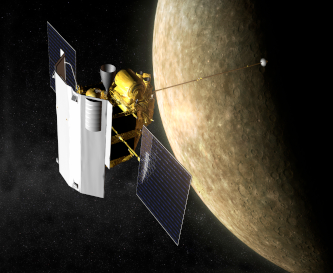- Series:Astronomy, Transcript English
Psalm 19:1
“The heavens declare the glory of God; and the firmament sheweth his handywork.”
 It isn’t easy to see Mercury. Because its orbit is close to the Sun, it can really only be viewed with the naked eye very shortly after sunset or very shortly before sunrise. I can count on one hand the number of times that I have successfully seen Mercury.
It isn’t easy to see Mercury. Because its orbit is close to the Sun, it can really only be viewed with the naked eye very shortly after sunset or very shortly before sunrise. I can count on one hand the number of times that I have successfully seen Mercury.
It isn’t easy to fly to Mercury, either. You might think that sending a rocket to Mercury should be like firing a gun. Providing you can calculate where Mercury will be in its orbit when your spacecraft arrives, you could send the rocket in that direction. But the acceleration needed to perform such a feat would mean that the arriving spacecraft would be traveling too fast to get into orbit around the tiny planet and would continue onward into the Sun, captured by its massive gravity.
The latest mission to Mercury, BepiColumbo, will require several flybys of Venus and Earth, to get exactly the correct speed to enter Mercury orbit in 2025, after seven years of maneuver.
Having next to no atmosphere to equalize the Sun’s massive heat energy, the planet’s surface can reach 800°F by day and plunge to -280°F by night. The extreme daytime temperature should have evaporated all the volatile materials into space; yet, it does not appear to have done so. Perhaps BepiColumbo will help scientists understand this better, but for now, we can marvel at the diversity of worlds that God has made, for his glory.
Prayer: Father God, we stand with the psalmist in awe of the Heavens, which declare Your glory. Amen.
Author: Paul F. Taylor
Ref: How Mercury and Venus can guide our hunt for alien life on exoplanets, < https://www.newscientist.com/article/mg24232350-900-how-mercury-and-venus-can-guide-our-hunt-for-alien-life-on-exoplanets/ >, accessed 6/25/2019. Image: Artist’s rendering of Messenger reaching Mercury, NASA Public Domain image.
© 2020 Creation Moments. All rights reserved.
